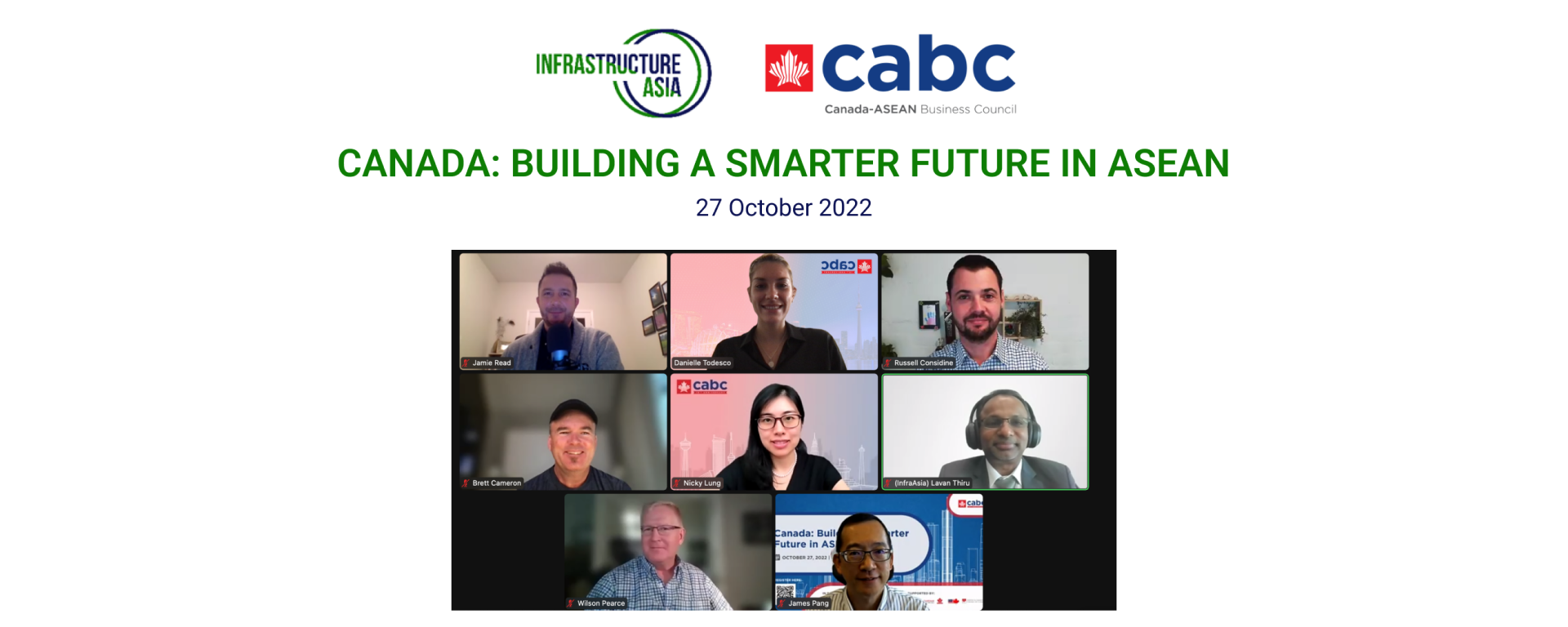Keynote Remarks by Lavan Thiru, Executive Director, Infrastructure Asia at Canada: Building a Smarter Future in ASEAN on 27 October 2022
Ladies and Gentlemen,
1. Good day to all. I am honoured to join you today virtually. Thank you to CABC for inviting me.
Introduction of Infrastructure Asia
2. For those who are unfamiliar, Infrastructure Asia is a project facilitation office set up by two Singapore Government entities - Enterprise Singapore, and Monetary Authority of Singapore. Our mandate is to support the social and economic growth in this region, including ASEAN, through sustainable infrastructure. We do so through engaging regional governments to promote best practices in structuring bankable infrastructure projects. This includes offering early-stage project scoping, capacity building, and catalysing project financing through the collective capabilities of Singapore-based companies and our partners such as Global Affairs Canada.
Building a Smarter Future – ASEAN context
3. Today, I am pleased to share some of Infrastructure Asia’s observations in the ASEAN smart infrastructure space, and two initiatives that we have been working on.
4. We are seeing intensified efforts by ASEAN member state governments and private sector to mobilise effective infrastructure investment, in response to intensifying climate risks and ambitious Net-Zero targets made at COP26. A two-pronged approach is needed to balance the demands of socioeconomic growth and climate action. The first is to improve the resiliency and sustainability of new-build infrastructure. The second is to manage our existing assets in smarter and more efficient ways.
5. For new build infrastructure, there is an extensive report by the ASEAN Smart Cities Network which features over 70 projects. Therefore, I will focus on the second approach as it is often overlooked, and share how Infrastructure Asia is driving smarter infrastructure in the form of Energy Efficiency Retrofits and reducing Non Revenue Water in ASEAN.
Case Study I – Energy Efficiency
6. Firstly, retrofitting existing buildings for Energy Efficiency is an important building block for smart cities. The International Finance Corporation (IFC) estimates that for emerging markets in Asia, retrofitting buildings for energy efficiency could reduce close to a billion tonnes of greenhouse gas emissions. However, we have observed a market gap caused primarily by misfit between project sizes – which are typically less than $2 million -- and the minimum ticket size required by financiers to provide project financing. There is also misalignment between building owners, facility managers and regulators on how to go about the retrofits, and apportioning the potential savings.
7. To address this market gap, Infrastructure Asia is working on an Energy Efficiency Aggregation Platform. This platform aims to bring together building owners in the region, energy services solution providers to create a pipeline of building retrofit projects and to catalyze this platform with finance, so as to scale up energy efficiency retrofits. While we may start with energy efficiency, there are other modular solutions that can ride on this for example, commercial & industrial roof-top solar, energy storage systems, EV charging etc.
Case Study II – Non Revenue Water
8. My second example is on reducing Non Revenue Water through smart digital solutions.
9. Water utilities in many ASEAN cities are struggling to keep up with the growth in water demand from urbanization and increased water consumption. A key reason is that significant amounts of water supplied through aged water supply pipelines are being lost through leakages. For example, the average Non Revenue Water in Indonesia is 32 percent, much higher than the initial target of 20 percent set by the government. This costs Indonesia an estimated 579 million US dollars per year in economic losses. Across ASEAN, the annual losses attributable to Non Revenue Water is in the order $2 billion a year.
10. To reduce non-revenue water, Infrastructure Asia and the World Bank are partnering water utilities in Indonesia and international solution providers to promote the adoption of digitalisation – such as virtual district metering areas and satellite image analysis – as well as innovative financing solutions – such as blended finance and performance-based contracting. We aim to expand this initiative to Vietnam and the rest of the region in the near future. Similar to the earlier example, this is just the start. Imagine the possibilities with smart meters that could help reduce non-technical losses where in some cases up to 50% of a utility’s output could be non-technical losses. Working on these low hanging fruits using proven technologies will further allow us to secure our energy and water needs.
11. To wrap up my sharing, I would like to thank the Canada-ASEAN Business Council for inviting me to speak at this session. Canada is home to many leading companies providing innovative products and services in smart infrastructure and urban solutions, represented by some of you here today. We hope that through such discussions and knowledge sharing sessions, we can find ways to align our shared interests and collaborate in developing quality & smart infrastructure in ASEAN.
12. Thank you and I wish for you to have a wonderful discussion ahead.

